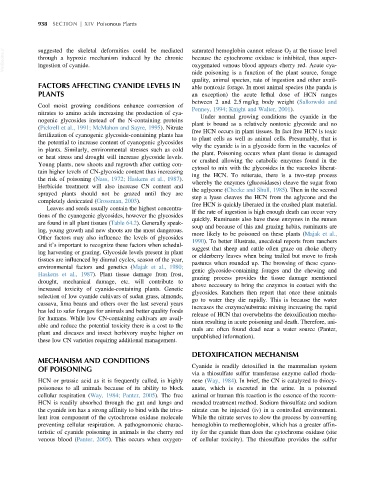Page 1006 - Veterinary Toxicology, Basic and Clinical Principles, 3rd Edition
P. 1006
938 SECTION | XIV Poisonous Plants
VetBooks.ir suggested the skeletal deformities could be mediated saturated hemoglobin cannot release O 2 at the tissue level
because the cytochrome oxidase is inhibited, thus super-
through a hypoxic mechanism induced by the chronic
oxygenated venous blood appears cherry red. Acute cya-
ingestion of cyanide.
nide poisoning is a function of the plant source, forage
quality, animal species, rate of ingestion and other avail-
FACTORS AFFECTING CYANIDE LEVELS IN able nontoxic forage. In most animal species (the panda is
PLANTS an exception) the acute lethal dose of HCN ranges
between 2 and 2.5 mg/kg body weight (Salkowski and
Cool moist growing conditions enhance conversion of
Penney, 1994; Knight and Walter, 2001).
nitrates to amino acids increasing the production of cya-
Under normal growing conditions the cyanide in the
nogenic glycosides instead of the N-containing proteins
plant is bound as a relatively nontoxic glycoside and no
(Pickrell et al., 1991; McMahon and Sayre, 1995). Nitrate
free HCN occurs in plant tissues. In fact free HCN is toxic
fertilization of cyanogenic glycoside-containing plants has
to plant cells as well as animal cells. Presumably, that is
the potential to increase content of cyanogenic glycosides
why the cyanide is in a glycoside form in the vacuoles of
in plants. Similarly, environmental stresses such as cold
the plant. Poisoning occurs when plant tissue is damaged
or heat stress and drought will increase glycoside levels.
or crushed allowing the catabolic enzymes found in the
Young plants, new shoots and regrowth after cutting con-
cytosol to mix with the glycosides in the vacuoles liberat-
tain higher levels of CN-glycoside content thus increasing
ing the HCN. To reiterate, there is a two-step process
the risk of poisoning (Nass, 1972; Haskens et al., 1987).
whereby the enzymes (glucosidases) cleave the sugar from
Herbicide treatment will also increase CN content and
the aglycone (Cheeke and Shull, 1985). Then in the second
sprayed plants should not be grazed until they are
step a lyase cleaves the HCN from the aglycone and the
completely desiccated (Grossman, 2003).
free HCN is quickly liberated in the crushed plant material.
Leaves and seeds usually contain the highest concentra-
If the rate of ingestion is high enough death can occur very
tions of the cyanogenic glycosides, however the glycosides
quickly. Ruminants also have these enzymes in the rumen
are found in all plant tissues (Table 64.2). Generally speak-
soup and because of this and grazing habits, ruminants are
ing, young growth and new shoots are the most dangerous.
more likely to be poisoned on these plants (Majak et al.,
Other factors may also influence the levels of glycosides
1990). To better illustrate, anecdotal reports from ranchers
and it’s important to recognize these factors when schedul-
suggest that sheep and cattle often graze on choke cherry
ing harvesting or grazing. Glycoside levels present in plant
or elderberry leaves when being trailed but move to fresh
tissues are influenced by diurnal cycles, season of the year,
pastures when rounded up. The browsing of these cyano-
environmental factors and genetics (Majak et al., 1980;
genic glycoside-containing forages and the chewing and
Haskens et al., 1987). Plant tissue damage from frost,
grazing process provides the tissue damage mentioned
drought, mechanical damage, etc. will contribute to
above necessary to bring the enzymes in contact with the
increased toxicity of cyanide-containing plants. Genetic
glycosides. Ranchers then report that once these animals
selection of low cyanide cultivars of sudan grass, almonds,
go to water they die rapidly. This is because the water
cassava, lima beans and others over the last several years
increases the enzyme/substrate mixing increasing the rapid
has led to safer forages for animals and better quality foods
release of HCN that overwhelms the detoxification mecha-
for humans. While low CN-containing cultivars are avail-
nism resulting in acute poisoning and death. Therefore, ani-
able and reduce the potential toxicity there is a cost to the
mals are often found dead near a water source (Panter,
plant and diseases and insect herbivory maybe higher on
unpublished information).
these low CN varieties requiring additional management.
DETOXIFICATION MECHANISM
MECHANISM AND CONDITIONS
Cyanide is readily detoxified in the mammalian system
OF POISONING
via a thiosulfate sulfur transferase enzyme called rhoda-
HCN or prussic acid as it is frequently called, is highly nese (Way, 1984). In brief, the CN is catalyzed to thiocy-
poisonous to all animals because of its ability to block anate, which is excreted in the urine. In a poisoned
cellular respiration (Way, 1984; Panter, 2005). The free animal or human this reaction is the essence of the recom-
HCN is readily absorbed through the gut and lungs and mended treatment method. Sodium thiosulfate and sodium
the cyanide ion has a strong affinity to bind with the triva- nitrate can be injected (iv) in a controlled environment.
lent iron component of the cytochrome oxidase molecule While the nitrate serves to slow the process by converting
preventing cellular respiration. A pathognomonic charac- hemoglobin to methemoglobin, which has a greater affin-
teristic of cyanide poisoning in animals is the cherry red ity for the cyanide than does the cytochrome oxidase (site
venous blood (Panter, 2005). This occurs when oxygen- of cellular toxicity). The thiosulfate provides the sulfur

